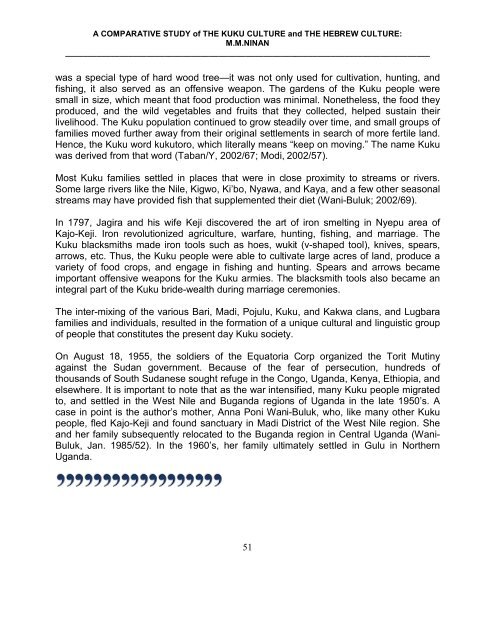kuku and Hebrew culture
You also want an ePaper? Increase the reach of your titles
YUMPU automatically turns print PDFs into web optimized ePapers that Google loves.
A COMPARATIVE STUDY of THE KUKU CULTURE <strong>and</strong> THE HEBREW CULTURE:<br />
M.M.NINAN<br />
_________________________________________________________________________________<br />
was a special type of hard wood tree—it was not only used for cultivation, hunting, <strong>and</strong><br />
fishing, it also served as an offensive weapon. The gardens of the Kuku people were<br />
small in size, which meant that food production was minimal. Nonetheless, the food they<br />
produced, <strong>and</strong> the wild vegetables <strong>and</strong> fruits that they collected, helped sustain their<br />
livelihood. The Kuku population continued to grow steadily over time, <strong>and</strong> small groups of<br />
families moved further away from their original settlements in search of more fertile l<strong>and</strong>.<br />
Hence, the Kuku word <strong>kuku</strong>toro, which literally means “keep on moving.” The name Kuku<br />
was derived from that word (Taban/Y, 2002/67; Modi, 2002/57).<br />
Most Kuku families settled in places that were in close proximity to streams or rivers.<br />
Some large rivers like the Nile, Kigwo, Ki’bo, Nyawa, <strong>and</strong> Kaya, <strong>and</strong> a few other seasonal<br />
streams may have provided fish that supplemented their diet (Wani-Buluk; 2002/69).<br />
In 1797, Jagira <strong>and</strong> his wife Keji discovered the art of iron smelting in Nyepu area of<br />
Kajo-Keji. Iron revolutionized agri<strong>culture</strong>, warfare, hunting, fishing, <strong>and</strong> marriage. The<br />
Kuku blacksmiths made iron tools such as hoes, wukit (v-shaped tool), knives, spears,<br />
arrows, etc. Thus, the Kuku people were able to cultivate large acres of l<strong>and</strong>, produce a<br />
variety of food crops, <strong>and</strong> engage in fishing <strong>and</strong> hunting. Spears <strong>and</strong> arrows became<br />
important offensive weapons for the Kuku armies. The blacksmith tools also became an<br />
integral part of the Kuku bride-wealth during marriage ceremonies.<br />
The inter-mixing of the various Bari, Madi, Pojulu, Kuku, <strong>and</strong> Kakwa clans, <strong>and</strong> Lugbara<br />
families <strong>and</strong> individuals, resulted in the formation of a unique cultural <strong>and</strong> linguistic group<br />
of people that constitutes the present day Kuku society.<br />
On August 18, 1955, the soldiers of the Equatoria Corp organized the Torit Mutiny<br />
against the Sudan government. Because of the fear of persecution, hundreds of<br />
thous<strong>and</strong>s of South Sudanese sought refuge in the Congo, Ug<strong>and</strong>a, Kenya, Ethiopia, <strong>and</strong><br />
elsewhere. It is important to note that as the war intensified, many Kuku people migrated<br />
to, <strong>and</strong> settled in the West Nile <strong>and</strong> Bug<strong>and</strong>a regions of Ug<strong>and</strong>a in the late 1950’s. A<br />
case in point is the author’s mother, Anna Poni Wani-Buluk, who, like many other Kuku<br />
people, fled Kajo-Keji <strong>and</strong> found sanctuary in Madi District of the West Nile region. She<br />
<strong>and</strong> her family subsequently relocated to the Bug<strong>and</strong>a region in Central Ug<strong>and</strong>a (Wani-<br />
Buluk, Jan. 1985/52). In the 1960’s, her family ultimately settled in Gulu in Northern<br />
Ug<strong>and</strong>a.<br />
51


















